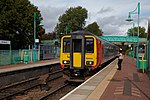Langwith Colliery railway station
1894 establishments in England1945 disestablishments in EnglandDisused railway stations in DerbyshireEast Midlands railway station stubsFormer Midland Railway stations ... and 4 more
Pages with no open date in Infobox stationRailway stations in Great Britain closed in 1945Railway stations in Great Britain opened in 1894Use British English from February 2022
Langwith Colliery railway station served the miners of the colliery in Whaley Thorns, Derbyshire, England, from 1894 to 1945 on the Mansfield to Worksop line.
Excerpt from the Wikipedia article Langwith Colliery railway station (License: CC BY-SA 3.0, Authors).Langwith Colliery railway station
Bathurst Terrace,
Geographical coordinates (GPS) Address Nearby Places Show on map
Geographical coordinates (GPS)
| Latitude | Longitude |
|---|---|
| N 53.2303 ° | E -1.2079 ° |
Address
Bathurst Terrace
Bathurst Terrace
NG20 9BL , Langwith
England, United Kingdom
Open on Google Maps







